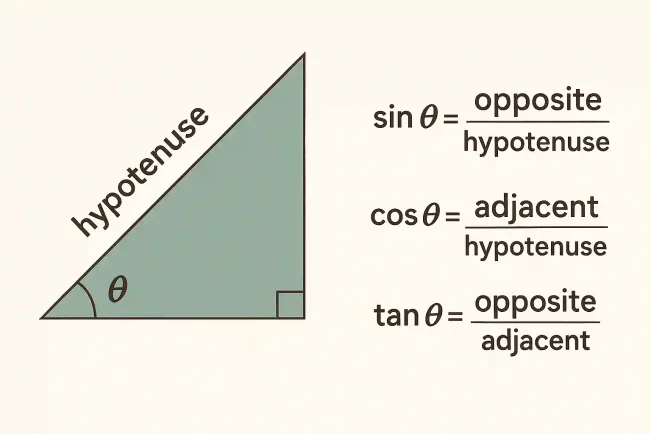Kodeclik Blog
When should you take trigonometry?
Imagine standing on a beach and trying to guess how far out a ship is without jumping into the water, or watching Spider-Man swing between skyscrapers and wondering how artists figure out the perfect arc of his web. This is trigonometry!
Lets dive in!
What is trigonometry?
Trigonometry is the branch of mathematics that studies the relationships among the angles and sides of triangles, but its reach extends far beyond three-sided figures. At its core are six fundamental trigonometric functions—sine, cosine, tangent, and their reciprocals—that let us translate angles into ratios and vice versa.
The six trigonometric functions create a powerful toolkit for modeling any situation that repeats in a wave-like pattern, rotates around a circle, or needs precise measurement when direct length data are hard to get.

Because trig builds a bridge between geometry and algebraic functions, it is often described as the “gateway language” that transforms shapes into numbers that a graphing calculator—or a later calculus course—can manipulate.
Where is trigonometry useful?
Open almost any field that measures, maps, or moves and you’ll find trig hiding in plain sight!
Engineers rely on it to calculate forces on bridges, the stress on airplane wings, or the vibrations in skyscrapers during high winds.
Game developers encode trigonometric formulas to animate characters that pivot naturally and to render realistic lighting and shadows.
Trig equations govern how your GPS pinpoints a car’s position, how medical imaging reconstructs a 3-D model of a heart, and how astronomers derive the distance to a newly discovered exoplanet.
Even seemingly distant areas—like music production, where sound waves are mixed, or economics, where cyclical trends are forecast—lean on the same sine and cosine curves introduced in a first-semester trig class.
What are the prerequisites to mastering trigonometry?
You do need a solid algebra and geometry foundation before trig will click.
Algebra I and II teach you to rearrange formulas, solve quadratic and rational equations, and manipulate exponents—skills that reappear when you work with trigonometric identities and inverse functions.
Geometry contributes angle relationships, similar triangles, and the logic of proofs, so you recognize why the sine of 30° always equals ½ no matter the triangle’s size.
Comfort with the unit-circle definition of angles in degrees and radians lets you read graphs efficiently and transition seamlessly into calculus later. If you’re shaky on these topics, devote time to brushing them up first; trig builds on them relentlessly.
Is there a separate course for trigonometry?
In many schools, trigonometry is offered typically as part of a pre-calculus course. Sometimes it can be part of a combined “Algebra II/Trigonometry” sequence, and which version you encounter depends on your district’s curriculum.
A dedicated trig class dives deeply into angle-measure systems, the six trig functions, identities, inverse functions, and real-world applications like solving oblique triangles with the Law of Sines and Law of Cosines—often with time for hands-on projects (surveying, sound waves, or astronomy).
When trig is embedded in Pre-Calculus, the material is the same but compressed, sharing the stage with analytic geometry, vectors, sequences, and an introduction to limits to prepare you for calculus the following year.
Does trigonometry come after algebra?
Yes, as we stated above, trigonometry takes everything you just learned about equations and throws in rotating arrows and circles. Most U.S. high-school sequences place Algebra I in 8th or 9th grade, Geometry the next year, and Algebra II right before or alongside Trigonometry/Pre-Calculus.
The algebra skills you acquire—factoring, solving systems, graphing polynomial and rational functions—are prerequisites because trigonometric identities often require the same manipulations, just dressed in sine and cosine symbols. Skipping ahead without that algebra fluency tends to turn trig homework into a frustrating memory game instead of a logical exercise.
Does trigonometry come before calculus?
Almost always. Calculus depends on limits, derivatives, and integrals of trigonometric functions to describe motion, area, and growth in the real world. You’ll differentiate sin x, integrate cos x, and prove that the derivative of tan x is sec²x—all tasks that assume you already know how those functions behave!
While some accelerated programs blend trigonometry into the early weeks of a Calculus AB course, students are still expected to arrive knowing the unit circle, common angle values, and basic identities. Learning trig concurrently with calculus can work for motivated learners, but mastering it first allows you to dive into calculus concepts rather than pausing to memorize 30-60-90 triangles.
What grade should I take trigonometry in?
For most college-prep tracks, trig (often folded into a Pre-Calculus course) lands in 11th grade, giving students an algebra-geometry-algebra II buildup over grades 8–10. If you’re in an accelerated pathway—say, Algebra I in 7th or 8th grade—you might reach trig as early as 9th or 10th grade and still have room for AP Calculus AB or BC before graduation.
When deciding, consider your comfort with prior math, your workload from other advanced classes, and your future goals: STEM majors and competitive engineering programs like to see calculus senior year, so earlier trig can be strategic. Conversely, forcing trig too soon can backfire if gaps in algebra or geometry slow you down later, so it’s wiser to take it when you’re ready to succeed than simply to race ahead.
Summary
Trigonometry gives you the tools to translate shapes, rotations, and movements into numbers you can graph and understand. It might sound abstract at first, but if you’ve ever aimed a basketball, tuned a guitar, or marveled at a rainbow, you’ve already witnessed trig at work!